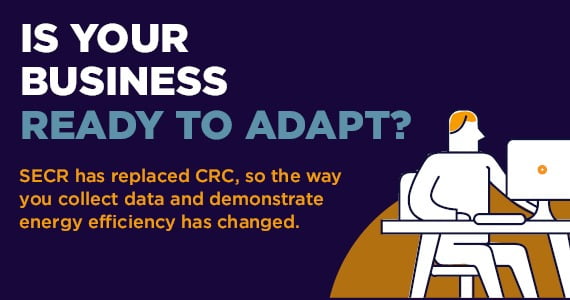
Don’t second guess SECR
This year, 11,900 businesses will need to comply with the new Streamlined Energy and Carbon Reporting (SECR) scheme for the first time. While the scheme is intended to make energy reporting easier, getting to grips with new rules and regulations can be complex for any organisation. SECR has been brought in to replace the Carbon […]
This year, 11,900 businesses will need to comply with the new Streamlined Energy and Carbon Reporting (SECR) scheme for the first time. While the scheme is intended to make energy reporting easier, getting to grips with new rules and regulations can be complex for any organisation.
SECR has been brought in to replace the Carbon Reduction Commitment (CRC), which many businesses found difficult to manage. As SECR is intended to bring the benefits of energy and carbon reporting to a wider range of businesses, many more will be eligible for SECR than CRC, which only affected around 4,000 organisations. A significant proportion of those that are already complying with ESOS (around 10,000 businesses) will also need to comply with SECR.
While there will be some overlap between the requirements of SECR, CRC and ESOS, it’s important that businesses are fully aware of what they need to do to achieve SECR compliance. So, if your business is affected by SECR, here’s what you need to know …
Is your business affected by SECR?
Your business will be affected by SECR if:
– You are a UK quoted company
– You are a UK registered company or LLP with at least two of the following: more than 250 employees; turnover over £36m; a balance sheet total of over £18m
If your business was required to comply with CRC, you may not be required to participate in SECR as the qualification criteria for SECR relates to business size rather than energy consumption. However, if you were affected by CRC, you will notice a number of similarities in the reporting obligations.
How is SECR different?
Like CRC, SECR requires eligible businesses to report on their emissions from their UK energy use, including onsite and transport energy. Global companies must also report their global energy use and greenhouse gas emissions. Much of the data businesses must collect for SECR is the same data they will need to collect for ESOS (if they are also affected by ESOS, which many will be) and they must also quote an intensity metric, like that supplied for Mandatory Greenhouse Gas (MGHG) reporting.
However, there are some key differences that SECR brings with it. Unlike ESOS, SECR doesn’t require participants to identify efficiency opportunities, but instead asks them to report on any energy efficiency actions they have taken in that financial year. This represents a real opportunity for businesses affected by both SECR and ESOS to make the most of their compliance obligations. Once they have identified areas for energy saving within their ESOS reports, businesses should ensure they act on them so that they can not only bring down their consumption, but also demonstrate their sustainability efforts within their SECR reports.
What should businesses be doing now?
Affected businesses should be acting now to achieve SECR compliance, because they will need to submit their first SECR report within the next 18 months. If your financial year begins in April, you will need to submit your SECR report shortly after 31st March 2020, while if your financial year begins in January 2020, you will need to submit your report in early 2021.
So if you’re required to submit your report after March 2020, you should already be preparing for compliance by collecting data on your energy consumption on a monthly or quarterly basis to ensure you’re not left with a massive task to complete at the last minute. If you’re new to energy reporting, you will also need to factor in time to prepare your energy reporting systems and processes for data collection. Equally if you’re required to submit your report in January 2021, our recommendation would be that you begin to consider the energy efficiency measures you could implement in the forthcoming months that could be included in the annual SECR report.
With the ESOS Phase 2 deadline fast approaching (5th December 2019), you may already be collecting the data you need. If your business is affected by ESOS and you have already carried out your ESOS audit, then you should have some recommendations for energy efficiency improvements to hand. You should consider implementing these recommendations, as doing so will be beneficial when it comes to demonstrating the steps you have taken to improve your energy use and carbon emissions, as this is required within your SECR report.
Your chance to shine
At Inspired, we’re encouraging all businesses to realise the opportunity that SECR presents to save money and improve your sustainability credentials. If you’re taking action to become more energy efficient within your organisation, your SECR report is a great way to promote this to your customers, boost your CSR and stand out from your competitors.
We want to make it as easy as possible for you to achieve SECR compliance and be recognised for your efficiency efforts. With our SECR service, we’ll provide you with quarterly updates on your progress, giving you up-to-date insight on your energy consumption, ongoing efficiency projects and your best and worst performing sites. This gives you the chance to improve your energy usage within the reporting year and arms you with insights to inform your investment decisions and motivate your staff. We’ll even provide you with a SECR creative assets pack, with templates for you to simplify compilation of your final annual report.
To find out more about how our compliance experts can help you with the new SECR process, visit our SECR page, where you can also download our free SECR e-guide.










